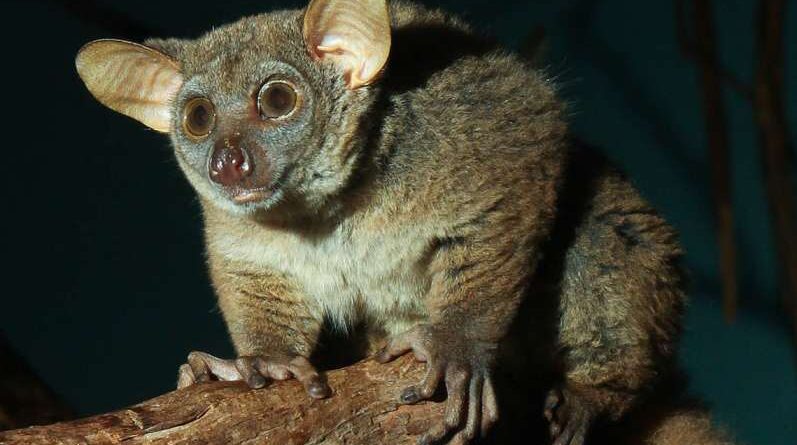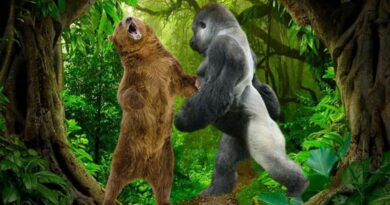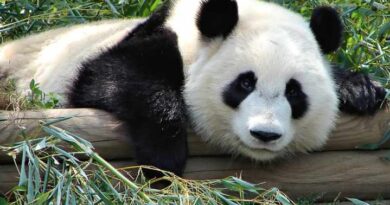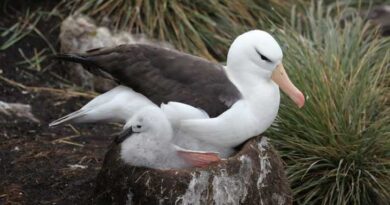Bushbaby
Many people believe the bushbaby got its name because it has a bushy tail and a soft, rounded body with huge eyes and a flat face, similar to that of a human baby. However, the animal’s name was given to it not because of its bushy coat, but because it lives in the African bush, and not because it resembles a baby, but because it screams like one. They sleep in a nest of leaves in a hollow tree during the day and come out to hunt for food as dusk sets. They call to one another in the approaching darkness with a high-pitched wail that sounds like a human baby in distress.
Although bushbabies are related to monkeys and apes, they resemble a squirrel more than a monkey the first time you encounter one scampering around in the bushes. It’s a fantastic jumper, capable of making tremendous jumps from one tree to the next and landing with the dexterity of a circus acrobat. It can even use its long, bushy tail as a rudder to change direction in mid-air. Its back legs are significantly longer than its front ones, so it starts a leap by bending them before straightening them as it takes off. All four of its limbs are fully extended in the air, ready to catch hold of the branch at which it has targeted and cushion the landing shock. It needs to be seen to be believed how quickly these small animals can fling themselves around in the trees at night. Nothing could possible catch them since they are so fast. In fact, it’s nearly impossible to follow them with your eyes in the dark light. Their secret is that their eyes see in low light far better than ours. They can see as clearly in the dusk as we do in the daylight with their enormous black pupils fully open.
They upset the insects that have just settled down to spend the night clinging to a twig or a leaf as they leap around at the start of an evening’s hunting. The bushbaby’s acute eyes identify these insects as soon as they start moving around, and they are caught with a fast dart. They are always snatched up in a unique way. With its hind feet clinging to a branch, the bushbaby flings its body forward. It snatches out with its hands and takes the prey with its fingers at the same time. It then quickly transports it to its mouth, where it starts to eat it with its small, needle-sharp teeth. When it comes to hunting, the bush baby is so fast and precise that it can even snare a little gnat that is flying around close. Its keen ears assist its large eyes in capturing prey.
These are incredibly dynamic, twitching and twisting in different directions as the animal moves around in the branches. Little rib-like folds of skin can be seen on the insides of the ears. These aid in directing the sounds of even the tiniest, most minute insects into the ears. In fact, the bushbaby is similar to a bat that can’t fly but can use echolocation to hunt insects at night, just like bats. The animal uses its echolocation system to emit a stream of very high-pitched squeaks. If these small sounds, which are so high that we humans can’t hear them, contact an object, they bounce back and reach the hunter’s ears as an echo. The faster an object is approached, the faster the sound returns. When an object moves, the echoes alter, moving information about its position, speed, and direction. No bug, even at night, is immune from such a detection weapon.
Bushbabies consume small mice, lizards, tree frogs, young birds, eggs, snails, fruits, and berries in addition to insects. When they’ve finished eating, they carefully clean themselves by grooming their lower teeth. These teeth are small and resemble the “tooth” of a small comb. Their toilet is nearly complete once their dense fur has been thoroughly combed, but they still need to add the finishing touches. This entails a nice scratch along the back of the neck, which their tooth comb is unable to reach. This scratching is carried out with a particular claw. Except for the second toe, all of their fingers and toes have flat nails, similar to ours. The “scratching claw” is a toe on each hind foot that possesses a sharp claw instead of a flat nail.
It’s also used to clean out those all-important ears, which must be kept in tip-top shape. As if having good vision and hearing weren’t enough, the bushbabies have a keen sense of smell as well. They have a moist nose, unlike their monkey relatives. They are more like dogs than monkeys in this regard, and they, like dogs, can discover their prey by scent with incredible accuracy. They can also use their noses to track their own and their companions’ movements.
They do it in a spectacular manner. They raise a breath and lift one foot off the branch every now and then. They squirt a few drips of pee over their foot’s sole and brush it against one of their hands. After that, they raise the other foot and repeat the process. Their fragrant urine has now plastered both their hands and the soles of their feet, and when they scramble about on the branches, they leave a personal fragrance trail wherever they go.
Because of their easy sense organs, the bushbabies have little trouble finding food. They are extremely successful animals that can be found all over tropical Africa in a variety of habitats, from wet rainforests to arid bushlands. Because they sleep during the day, visitors to game parks rarely encounter them and are frequently unaware of their prevalence. Females all have their own small, set territories where they live and never leave them. The males have larger territories, and the boss male will visit each female one by one, checking to see if any of them is ready to mate. A nest of twigs and leaves is where the baby is born. It is not carried around on the mother’s body like a baby monkey when it is very young. She leaves it in the nest while she goes hunting, although she is seldom gone for long periods of time. She takes it with her as it gets a little older, and she prefers to carry it by the scruff of the neck, like a cat, rather than letting it cling to her fur.
When the young are around three months old, they are weaned. They are able to actively follow the mother around at night when she goes hunting at this time. She lets them stay with her until they reach adulthood, which is about the end of their second year. They may stay in their mother’s area as adults if they are females. As a result, it’s not uncommon to find a small group of related females and their children living together.
Young boys, on the other hand, must leave the maternal home and seek their fortune elsewhere. Bushbabies have few opponents, yet they are cautious and continuously on the watch for trouble. If they have to move from one clump of bushes to another on the ground, they grow agitated and, instead of sprinting over the ground, dash across the open space like small kangaroos, hopping along on their hind legs as swiftly as possible.
They, like many other animals, have an easy body coloration that helps them blend in with their surroundings. On the underside of their bodies, their brown fur is paler. Counter-shade is a type of shading that acts in opposition to the shading created by the sun or moon’s light. When the sun shines down from above, the animal’s tummy is cast in shade. Its underside would appear darker if its fur was the same colour all around. Its back would appear paler due to the brighter lighting. The bushbaby’s distinctive colouring compensates for the fact that its belly fur is lighter than its back fur. As a result, the animal appears flat and is less visible than when it is perched on a branch. This helps to keep it hidden from hungry killers’ eyes.
You might be wondering how a bushbaby ends up in a zoo. How can collectors manage to capture one if it is so brilliantly acrobatic, is so well camouflaged by its counter-shaded brown fur, and only comes out at night? Bushbabies, on the other hand, have a serious problem. weakness. They enjoy sipping wine. The collectors just pour palm wine, wait until the bushbabies are intoxicated and asleep, and then pick them up without trouble.



